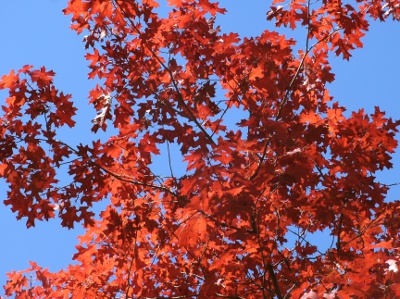Northern Red Oak Tree
Category: Deciduous Trees

Facts about Northern Red Oak Tree, "Scientific name for Quercus rubra". The Northern Red Oak Tree, Quercus rubra is a fast growing deciduous tree which originates from North America, in the areas of southeast Canada and northeastern United States. It has established from Nova Scotia to the north end of the Great Lakes and south to Georgia .
Northern Red Oak Tree can grow upright to a maximum length of about 60 to 75 feet (18.28 to 22.86 meters) and sometimes but rare one hundred (30.48 meters) and a trunk of approximately twenty to forty inches (50 to 100 cm) in diameter. It is important to note that open-established Northern Red Oak Trees sometimes grow to a shorter height with a stouter trunk of about six feet (1.82 meters) in diameter.
The Northern Red Oak Tree’s branching is perpendicular to the stems, stout and forms a round- topped narrow head. The Northern Red Oak Tree can live for many years with some being over five hundred years old. The northern red oak tree has a noticeable bark of shiny, round thin ridges which are stripped down to the center. The color of the bark can be brown-gray eventually turning dark-brown as the tree matures to age.
Northern Red Oak Tree’s leaves are produced from the tree’s pink convolute buds. They arranged alternately, lobed seven to nine times and have a length of about five to ten inches (12.7 to 25.4 cm) with a spread of four to six inches (10.1 to 15.2 cm). They have broad, flat bases which becomes narrow towards the top ending at the bristle-pointed tip. The leaves mature and remain hairy with a pale yellowish-green color and a smooth, shiny, dark green color above which turns red in autumn.
Northern Red Oak Tree produces acorns which takes eight months to develop after the flowers have been pollinated. These fruits can come either in pairs or singly and are usually sessile, brown in color and are 1 1/2 to 1 1/4 inches (3.8 to 3.1 cm) long. Their cups are shallow and saucer-shaped measuring about 3/4 inches (2 cm) wide.
A Full grown Northern Red Oak Tree can absorb as much as 48 pounds (21.77 kg) of carbon dioxide a year. The same Northern Red Oak Tree could also produce enough oxygen in a day for two people. In a single day, a large Northern Red Oak Tree can drink up to 100 gallons (378.5 liter) of water from the ground and discharge it into the air.
You can tell a Northern Red Oak Trees age by the number of growth rings. Growth rings size shows what kind of conditions accrued that year, the temperature and if it was a dry or wet year.
Bark of the Northern Red Oak Tree protects it from the elements and is made up of dead cells.
The Northern Red Oak Tree can be grown in moist to well-drained slightly acidic soils. However, it can also do well in various soil conditions. It has frequently established in boarders of streams and glacial drifts.
Northern Red Oak Tree roots usually grow two to three times the width of the tree branches. The ideal time to fertilize your Northern Red Oak Tree is in late fall or early spring. If you want to transplant a Northern Red Oak Tree do it in fall, this is ideal for most trees.
Northern Red Oak Tree growth is referred to as Meristem (The undifferentiated embryonic plant tissue from which new cells are created, as that at the tip of a root or stem). This tissue can be found at the tips of shoots and leaves. Inside the stem growth in thickness occurs at the vascular cambium.
Northern Red Oak Trees make their own food from sunlight, carbon dioxide, water, and nutrients from the soil.
The Northern Red Oak Tree can be grown for ornamental values. In addition, it can also be used for timber, lumber or for firewood. It can also be used in construction works including furniture, flooring, fence posts and rail road ties. The acorns are food for some wild animals. The Northern Red Oak Tree is found in zones 3–8.

 Back To Category Deciduous Trees
Back To Category Deciduous Trees